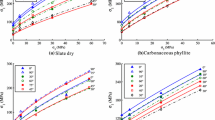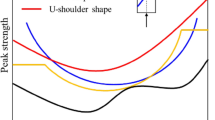Abstract
Transversely Isotropic (TI) rocks exhibit anisotropic strength characteristics due to uniform structural features such as foliation, lamination, schistosity, cleavage planes, layering, bedding planes, and stratified layers. In the field of rock engineering, particularly in mining, civil engineering, geology, and petroleum, it is crucial to have a reliable and comprehensive anisotropic failure criterion for TI rocks to support the design process of engineering structures. Therefore, this study aims to develop an anisotropic failure model for TI rocks that integrates new parameters into the intact Hoek and Brown failure criterion. This focus on deriving simplified parameters aims to create a generalized model with improved accuracy in predicting anisotropic strength. The proposed model includes anisotropy factors, such as the unconfined anisotropic strength \(({\sigma }_{c\beta })\), anisotropic effect \(({A}_{e})\), and type of anisotropic curve \(({A}_{m})\). Experimental data of layered sandstone tested under various orientations and confining pressures were utilized to validate the model. Additionally, the proposed failure model underwent evaluation using an artificial neural network and published data on layered rocks. The resulting metrics, including R2 and Root Mean Square Error, were found to be within acceptable standards. This indicates that the proposed criterion can accurately predict failure strength for different rock types.

















Similar content being viewed by others
Data Availability
All data have been provided within the manuscript and no external data is necessary.
References
Ambrose J (2014) Failure of Anisotropic Shales under Triaxial Stress Conditions, In; thesis submitted to Department of Earth Science and Engineering. Imperial College London
Asadi M, Bagheripour MH (2014) Modified criteria for sliding and non-sliding failure of anisotropic jointed rocks. Int J Rock Mech Min Sci 73:95–101. https://doi.org/10.1016/j.ijrmms.2014.10.006
Bagheripour MH, Rahgozar R, Pashnesaz H, Malekinejad M (2011) A complement to Hoek-Brown failure criterion for strength prediction in anisotropic rock. Geomechan Eng 3(1):61–81. https://doi.org/10.12989/gae.2011.3.1.061
Barton N, Quadros E (2014) Anisotropy is everywhere, to see, to measure, and to model. Rock Mech Rock Eng 603(July):632–637. https://doi.org/10.1007/s00603-014-0632-7
Blair TC, McPherson JG (1999) Grain-size and textural classification of coarse sedimentary particles. J Sediment Res 69(1):6–19. https://doi.org/10.2110/jsr.69.6
Cheng J, Wan Z, Zhang Y, Li W, Peng SS, Zhang P (2015) Experimental study on anisotropic strength and deformation behavior of a coal measure shale under room dried and water saturated conditions. Shock Vib 2015:1–13. https://doi.org/10.1155/2015/290293
Cheng C, Li X, Qian H (2017) Anisotropic failure strength of shale with increasing confinement: Behaviors, factors and mechanism. Materials. https://doi.org/10.3390/ma10111310
Cho JW, Kim H, Jeon S, Min KB (2012) Deformation and strength anisotropy of Asan gneiss, boryeong shale, and yeoncheon schist. Int J Rock Mech Min Sci 50:158–169. https://doi.org/10.1016/j.ijrmms.2011.12.004
Donath F A (1964). Strength variation and deformational behaviour in anisotropic rock. In: Judd W (Ed.) State of Stress in the Earth’s Crust, pp 281–298
Duveau G, Shao JF (1998) A modified single plane of weakness theory for the failure of highly stratified rocks. Int J Rock Mech Min Sci 35(6):807–813. https://doi.org/10.1016/S0148-9062(98)00013-8
Duveau G, Shao JF, Henry JP (1998) Assessment of some failure criteria for strongly anisotropic geomaterials. Mechan Cohesive-Frict Mater 3(1):1–26
Hoek E, Brown ET (1980) Underground excavations in rock. Institution of Mining and Metallurgy, London
ISRM (1981) The ISRM suggested methods for rock characterization, testing and monitoring. In: Brown ET (Ed.) Pergamon Press, Oxford
Jaeger JC (1960) Shear failure of anisotropic rocks. Geol Mag 97:65–72. https://doi.org/10.1017/S0016756800061100
Liu X, Feng X-T, Zhou Y (2022) Influences of schistosity structure and differential stress on failure and strength behaviours of an anisotropic foliated rock under true triaxial compression. Rock Mech Rock Eng 56:1273–1287. https://doi.org/10.1007/s00603-022-03133-x
Maazallahi V, Majdi A (2021) Directional rock mass rating (DRMR) for anisotropic rock mass characterization. Bull Eng Geol Env 80:4471–4499. https://doi.org/10.1007/s10064-021-02143-3
Nasseri MHB, Rao KS, Ramamurthy T (2003) Anisotropic strength and deformation behavior of Himalayan schists. Int J Rock Mechan Mining Sci 40(1):3–23. https://doi.org/10.1016/S1365-1609(02)00103-X
Niandou H, Shao JF, Henry JP, Fourmaintraux D (1997) Laboratory investigation of the mechanical behaviour of tournemire shale. Int J Rock Mech Min Sci 34(1):3–16. https://doi.org/10.1016/S1365-1609(97)80029-9
Qin Q, Li K, Li M, Abbas N, Yue R, Qiu S (2024) An anisotropic failure criterion for jointed rocks under triaxial stress conditions. Rock Mech Rock Eng. https://doi.org/10.1007/s00603-023-03684-7
Raclin J (1984) Contributions theÂoriques et expeÂrimentales aÁ l’eÂtude de la plasticiteÂ, de l’eÂcrouissage et de la rupture des solides anisotropes. TheÁse de Docteur EÁs Sciences, Grenoble
Ramamurthy T (1993) Strength and modulus responses of anisotropic rocks. In: Hudson JA (ed) Comprehensive rock engineering Fundamentals, vol 1. Pergamon Press, Oxford, pp 313–329
Ramamurthy T, Rao GV, Singh J (1993) Engineering behaviour of phyllites. Eng Geol 33:209–225. https://doi.org/10.1016/0013-7952(93)90059-L
Saeidi O, Vaneghi RG, Rasouli V, Gholami R (2013) A modified empirical criterion for strength of transversely anisotropic rocks with metamorphic origin. Bull Eng Geol Environ. https://doi.org/10.1007/s10064-013-0472-9
Saeidi O, Rasouli V, Vaneghi RG, Gholami R (2014) Geoscience frontiers a modified failure criterion for transversely isotropic rocks. Geosci Front 5(2):215–225. https://doi.org/10.1016/j.gsf.2013.05.005
Saroglou H, Tsiambaos G (2008) A modified Hoek-Brown failure criterion for anisotropic intact rock. Int J Rock Mech Min Sci 45:223–234. https://doi.org/10.1016/j.ijrmms.2007.05.004
Shi X, Yang X, Meng Y, Li G (2016) An anisotropic strength model for layered rocks considering planes of weakness. Rock Mech Rock Eng 49(9):3783–3792. https://doi.org/10.1007/s00603-016-0985-1
Singh M, Samadhiya NK, Kumar A, Kumar V, Singh B (2015) A nonlinear criterion for triaxial strength of inherently anisotropic rocks. Rock Mech Rock Eng. https://doi.org/10.1007/s00603-015-0708-z
Tien YM, Kuo MC (2001) A failure criterion for transversely isotropic rocks. Int J Rock Mech Min Sci 38:399–412. https://doi.org/10.1016/S1365-1609(01)00007-7
Wu Y, Li X, He J, Zheng B (2016) Mechanical properties of longmaxi black organic-rich shale samples from south China under uniaxial and triaxial compression states. Energies. https://doi.org/10.3390/en9121088
Funding
No external funding was received for this research.
Author information
Authors and Affiliations
Contributions
Gowtham Ganesan: conceptualization, methodology, software, validation, writing-original drafting, writing-review and editing, visualization, and formal analysis. Arvind Kumar Mishra – review, editing, validation and supervision.
Corresponding author
Ethics declarations
Conflict of interest
The authors declare that they have no known competing financial interests or personal relationships that could have appeared to influence the work reported in this paper.
Additional information
Publisher's Note
Springer Nature remains neutral with regard to jurisdictional claims in published maps and institutional affiliations.
Rights and permissions
Springer Nature or its licensor (e.g. a society or other partner) holds exclusive rights to this article under a publishing agreement with the author(s) or other rightsholder(s); author self-archiving of the accepted manuscript version of this article is solely governed by the terms of such publishing agreement and applicable law.
About this article
Cite this article
Ganesan, G., Mishra, A.K. A Modified Anisotropic Hoek and Brown Failure Criterion for Transversely Isotropic Rocks. Geotech Geol Eng (2024). https://doi.org/10.1007/s10706-024-02818-0
Received:
Accepted:
Published:
DOI: https://doi.org/10.1007/s10706-024-02818-0




